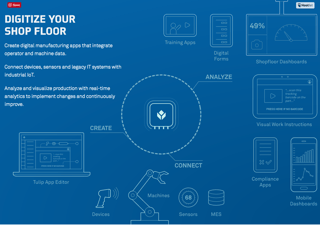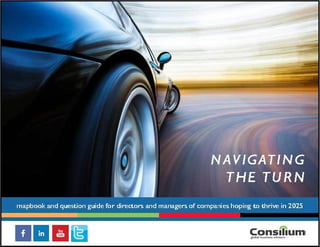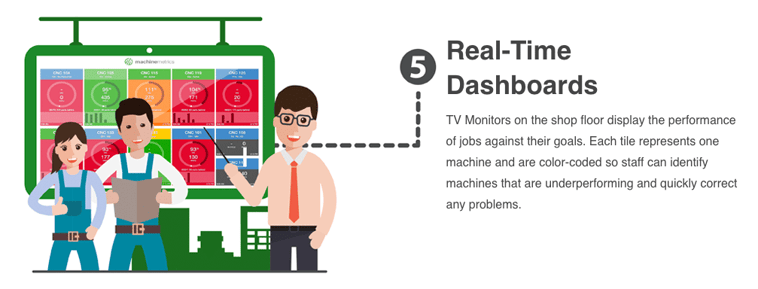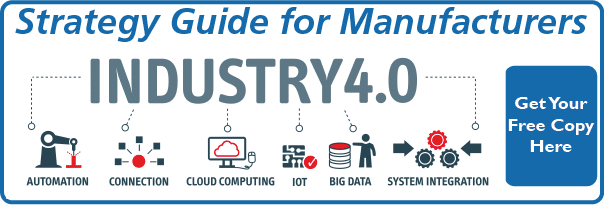Tweaking around the edges
When US manufacturers faced the wrath of low cost imports in the 80s & 90s they reacted in various ways.
Some folded their tent and quit. Some soldiered on enduring greater misery as margins collapsed and buyers' demands became more outrageous.
But a few....a few decided to seize the challenge. They did so in different ways, but generally there was some sort of manufacturing rethink that improved quality, reduced lead-time, reduced wasteful WIP and other hidden costs.
There's a similar challenge brewing today - actually two concurrent challenges.
One is in the imminent disruption of Manufacturing 4.0. The other in radically changing buyer behaviors.
Both will disrupt business as usual - and success in both requires strategic thinking from manufacturers. Strategic insights will be reflected in innovative approaches to business and revenue models, product offerings etc.
But many manufacturers, normally linear and incremental thinkers by nature, will respond with incremental change.
That didn't work in the 90s and it won't work now.
We can’t simply sit by and watch evolution happen around us or to us. We can’t sit frozen in a state of future shock. We need to not only react, we need to see things in ways that allow us to move in productive and also new directions. It takes a shift in perspective to see then do things differently. Otherwise, many of us iterate when we think we are innovating. What’s the difference?
Iteration is doing the same things better.
Innovation is doing new things that creates new value. It changes behavior.
Disruption is changed behavior that does new things and evening makes the old things obsolete.
We can’t simply do what we’ve always done because it’s the “go to,” gut-driven reaction. This is a time of disruption on all fronts. Sometimes legacy perspectives and personal beliefs prevent us from seeing change and its potential because we see it through a lens of what and who we are. That moment is defined by the past. And, that’s what make change, and innovation, difficult. Brian Solis
But a company doesn't have to completely change their revenue model to make some innovative changes in their complex sales and capital equipment marketing. Here are a couple examples of gradual experimentation. Call it perhaps, paradoxically, iterative innovation.
Virtual Reality - more than a gimmick
I routinely hear from clients that:
- when they can get in front of a prospect they often win deals
- the best meeting happens in their own factories - that's a huge credibility builder that cements relationships and often results in better solutions through collaboration
Yet the closest experience most companies offer prospects who can't visit their factories is the stale, stilted almost comical profile video. That's an example of an incremental solution. And it simply fails.
In contrast there's an innovative solution infrequently adopted by middle market manufacturers. Why aren't they using virtual reality? It's not just for gaming and sophisticated medical applications - there are a rapidly growing number of industrial sales and capital equipment marketing applications.
And at the intersection of manufacturing 4.0, 3D Printing (additive manufacturing) and VR, check out the tour of GE's 3D printing lab. (best from a mobile device) By the way...there's that pesky GE digital innovation again!
Business model & value innovation
While savvy middle market equipment manufacturers might be inclined to start to look at cloud capability, data focused models and ways that they can package value and services for customers, they might not be convinced yet to fully invest in Manufacturing 4.0 capabilities.
For those companies that want to experiment in the space, begin to learn the language and how to sell and market, and create a base for more disruptive innovation in their own products later, there are some cool technologies emerging which they can explore bundling with their capital equipment into recurring revenue type packages.
tulip
 In Gartner's Cool Vendors in Manufacturing Operations, 2017 they say “digitally enabling factory workers is on the radar for manufacturing leaders. New applications designed for non-IT savvy users to create their own applications, maintain content and data models, and apply various analytical techniques are emerging and will eventually challenge traditional approaches to manufacturing software.”
In Gartner's Cool Vendors in Manufacturing Operations, 2017 they say “digitally enabling factory workers is on the radar for manufacturing leaders. New applications designed for non-IT savvy users to create their own applications, maintain content and data models, and apply various analytical techniques are emerging and will eventually challenge traditional approaches to manufacturing software.”
One application they mention as an example of the trend is tulip. Tulip offers an easy to use system that allows companies to integrate operator / manual processes with IoT and legacy systems.
They see use cases of quality and training. I see another. One of the biggest challenges for capital equipment manufacturers customers is optimizing machine changeovers. As batches become shorter, and OEE becomes a more important focus, efficient changeovers become more critical.
While multi-axis servos help to make changeovers repeatable, there are certain functions (loading consumables, adjusting for environmental variables, and making small tweaks) which are left to operators. tulip could be the answer - with step by step demonstration and operator acknowledgment of changeover functions (even ability to incorporate machine vision to confirm), it seems to offer the ability to reduce the inefficiency. That would be a win-win for manufacturers and their customers.
machinemetrics.com
I'm an advocate of dashboards in marketing and sales - but of meaningful revenue growth numbers. Too often companies track vanity metrics - traffic for instance - which may be indicative but don't put a lever in their hands with context for how hard to pull it to make a necessary change. (I've written about them on the Databox blog and incorporate Databox in the toolkit which is part of my manufacturing revenue growth consulting program.)
It stands to reason that manufacturers should have them too - and many do. But they tend to be very elaborate and require extensive custom coding.
Until now.
Machinemetrics.com offers a really simple way to pull data off of machine controllers. It can be displayed as part of attractive and easily configured dashboards.
Capital equipment manufacturers could leverage this in three ways
First, they can bundle it with a machine sale as a recurring revenue component and begin to create those models. The cloud based functionality would allow them to remotely monitor - either as a paid service or perhaps an element of service packages they already offer.
Second, if they're selling OEE as a byproduct of their equipment, they could go a step further and implement OEE monitoring on all machines in a line - including theirs - to provide extended value and create a stickier customer relationship.
Third, they can begin to aggregate (probably anonymous) data. Monitoring multiple machines across factories, products and environments will allow them to not only gain insights that will help them improve designs, but likely prompt ideas for innovation and even create a base of data which could inform consulting they might develop as machines become secondary to process and data. (Clearly there are privacy and data issues to work through. They are going to be tackled - so you might as well get a jump start on it and start to realize value!)
It's clear that sharing economy and cloud based models will disrupt traditional complex machine sales models - it's time for capital equipment marketing teams to begin to position their companies for success.
Iterative innovation
 Here's the point - there's a middle ground for manufacturers. Iterative innovation.
Here's the point - there's a middle ground for manufacturers. Iterative innovation.
In other words taking bold steps...of a manageable size.
There's no need to bet the company, but there's a lot of opportunity to begin to experiment with recurring revenue/subscription models which are uncommon in the capital equipment sales world.
Incorporating IoT technologies that will provide substantial value to customers is a great way to begin to stretch even before a company is ready to roll its own out.
And there's another key point. Capital equipment marketing is no longer just about lead generation (already a position that's ahead of the trade show coordination and brochure creation which many think of.) Today marketing is a core function that sits at the intersection of the company and buyers. Collecting at least as much information as it dispenses, monitoring competitive threats and spotting trends.
A new breed of marketer - a polymath with business and technical background - could manage the "disruption skunk works" that every middle market company should be building.
These are all important strategic topics that need to be discussed though. And too often senior management and boards of directors focus on retrospective revenue rather than major disruptions that represent simultaneously threats and opportunities.




